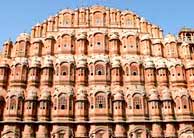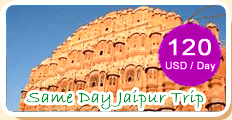
Jaipur Tour

 Jaipur is 260 km from Delhi and 240 km from Agra and forms the most chosen tourism golden triangle of Delhi, Agra and Jaipur. It a bustling capital city and a business centre with all the trapping of modern metropolis but yet flavoured strongly with an age-old charm that never fails to surprise a traveller. The old Jaipur painted in Pink can grip any visitor with admiration. Stunning backdrop of ancient forts Nahargarh, Amer, Jagarh and Moti Dungri are dramatic testimonials of the bygone era and a reminder of their lingering romance.
Jaipur is 260 km from Delhi and 240 km from Agra and forms the most chosen tourism golden triangle of Delhi, Agra and Jaipur. It a bustling capital city and a business centre with all the trapping of modern metropolis but yet flavoured strongly with an age-old charm that never fails to surprise a traveller. The old Jaipur painted in Pink can grip any visitor with admiration. Stunning backdrop of ancient forts Nahargarh, Amer, Jagarh and Moti Dungri are dramatic testimonials of the bygone era and a reminder of their lingering romance.Jaipur is named after its founder the warrior and astronomer sovereign Sawai Jai Singh II (ruled 1688 to 1744). The decision to move out of his hilltop capital Amer was also compelled by reasons of growing population and paucity of water. Moreover in the early seventh century the power of the great Mughals was dwindling with its aging
Monarch Aurangzeb and after several centuries of invasions the north was now quite and the wealth of the kingdom had become greater than before. Seizing upon this opportune time Jai Singh planned his new capital in the planes. Jaipur is a corroborative effort of Sawai Jai Singh's strong grounding in sciences and astrology and a Bengali architect Vidyadhar with a strong instinct for planning.
Jal Mahal Palace Jal Mahal Palace stands out as one of the proud monuments that has not lost its old imperial charm and grandeur. This palace is one of the most striking architectural landmarks and is extremely charming. Jal Mahal Palace at Jaipur should not be missed out by the tourists during their tour to Rajasthan.
Jal Mahal is an 18th century pleasure palace and is located in Jaipur, the capital city of Rajasthan. The palace is perched amidst Mansagar lake, which is in turn nestled amongst the Nahargarh hills. The Jal Mahal Palace, Jaipur is noted for its sophisticated design and grand architecture. The Palace was developed as a pleasure spot and was used for the royal duck shooting parties. A causeway leads to Jal Mahal Palace situated in the middle of Man Sagar lake, opposite the cenotaphs.
Hawa Mahal
The Hawa Mahal (literal meaning, palace of the winds) is an important landmark of the city of Jaipur, the pink city of India. It is an interesting building, although it is actually little more than a façade. This honeycombed building was originally built to facilitate the women of the royal household to watch the everyday life and processions of the city.
Among all the states of erstwhile princely India, Rajputana (now Rajasthan) is undoubtedly one of the most colorful. Despite their time-consuming preoccupation with war, the Rajputs, at all periods of their history, have been patrons of art and architecture. They were great builders, and their forts and palaces, built for reasons of security, residence and leisure of the Maharajas and their women, are not only impressive but a very important part of Rajasthan's cultural and architectural heritage.
Amber Fort
Amber Fort is situated in Amber, the ancient capital of the Kachhwaha Rajputs on a hillside overlooking Maotha lake, 11 km. from Jaipur on the Delhi - Jaipur road. A beautiful complex of palaces, halls, stairways, pillared pavilions, gardens and temples built by Maharaja Man Singh I, Mirza Raja Jai Singh and Sawai Jai Singh over a period of about two centuries. Amber is the classic romantic Rajasthan fort palace. It is a classic fusion of Mughal and Hindu architecture, built in red sandstone and white marble.
Nahargarh Fort
Nahargarh Fort was built by Sawai Raja Jai Singh in 1734. The fort is one of the major tourist attractions of the city. Nahargarh fort was built by Sawai Raja Jai Singh and later some splendid additions were done by the successors of Nahargarh-Fort-Jaipur-l Sawai Raja Jai Singh. The fort was renovated in the 19th century and some splendid features were added to the magnificent fort.
City Palace
City Palace, is situated at the heart of Jaipur. Each and every corner of this grandiose edifice enters through a person's eyes but descends directly to one's heart. Filled with interesting and enticing artifacts, the royal palace is both a repository of the culture and a family album of the long line of maharajas who ruled this Pink City for so many years. An impeccable blend of Rajasthani and Mughal architecture, the City Palace complex occupies a large area segregated into a series of voluminous courtyards, alluring gardens and magnificent buildings.
Rajmahal Palace
Raj Mahal Palace, Jaipur, built way back in 1729 is a popular heritage hotel in Jaipur that has a history of serving many a high-profile guests that include Queen Elizabeth II, Prince Philip, Prince Charles and Lady Diana. Set amidst 15 acres of lush green lawns, Raj Mahal Palace, Jaipur holds out the promise of letting the guests enjoy a royal experience.
The hotel renders excellent accommodation facilities to the guests and promises to make the stay an enjoyable and comfortable one for the guests. The rooms are provided with color televisions, cable connections, minibars, telephones, attached bathrooms with running hot and cold water, excellent room services and air conditioners.
Laxmi Narayan Temple
Located in the Southern part of Jaipur, the Laxmi Narayan Temple was constructed by the Birla family that has been one of the leading industrialist families of India for a long time.
The Laxmi Narayan Temple offers picturesque vistas as twilight sets in; the marble exterior of the temple begins to glow against the fascinating Jaipur skies and lies quite close to the Moti Doongri.
Samode palace
The Samode Palace was built 400 years ago, and the palace was converted into Heritage Hotel by the Samode family. The palace is a wonderful example of Rajput-Mughal architecture.
Samode Palace is 42 kms from Jaipur and is a perfect place to spend one's holidays. It is a place of great interest for people who appreciate culture and local arts. The village or town is famous for its magnificent havelis, mansions and handicrafts, so for your next holiday travel to Samode and see the rural life and flavors of Rajasthan.
Jantar Mantar
Jantar Mantar in Jaipur is the largest and one of the best preserved of five observatories constructed by Maharaja Sawai Jai Singh all over northern India. The Jantar Mantar in the Pink City consists of multiple structures of stone masonry build in varied and large geometric forms that have caught the attention of artists, architects and art historiographers throughout the world.
Govind devji temple
The Govind Dev Ji Temple was built in 1890 with the donation money received from Raja Man Singh. The temple is wonderfully placed between the Chandra Mahal and Badal Mahal in the City Palace complex . The temple complex becomes a hive of activity during Janmastami, a festival that commemorates the birth of Lord Krishna.
Central museum
Situated in the midst of Ramnivas Gardens, it is an imposing stone structure executed in the Indo-Persian style of architecture. The museum has a wide range of metal objects used for domestic purposes. Also on view area large collection of miniatures from the Bundi, Kota, Kishangarh, Udaipur and Jaipur schools of paintings.
Constructed in 1876, when the Prince of Wales, King Edward VII has visited India and designed by Colonel Sir Swinton Jacob. It was opened to public in 1886. Government Central Museum or Albert Hall is situated within the Ram Niwas Garden, which is the oldest Museum in the state.
Bissau palace
Hotel Bissau Palace in Jaipur was built by Rawal Raghubir Singhji in 1919. The hotel brings back the splendor of the past era that gives the guests a royal feeling.
The Thakurs of Bissau were a bristling, prickly lot, and were often at daggers drawn with other feudal chiefs. While their fort in the Shekhawati region was sold a few decades ago, the townhouse in Jaipur, called Bissau Palace, now functions as a hotel. Set in a garden, the rambling building has a quaint colonial air about it, somewhat ruined by the souvenir shops. The building inside recreates turn-of-the-century architecture combining English formality with the Rajput need for open courtyards and separate wings.
Albert museum
This museum was designed by Colonel Sir Swinton Jacob in 1876 for the purpose of greeting King Edward VII, Prince of Wales on his visit to India. After ten years, it was opened to the public. Since 1969, the galleries on the ground floor of the museum have been thoroughly rebuilt and remodeled.
The Alber Hall Museum in Jaipur is one of the oldest museums of the state. The Albert Hall museum was built to welcome the Prince of Wales on his visit to India in 1876. Located amidst the Ram Niwas Bagh in Jaipur, the Albert Hall museum has an assortment of rare articles including textiles, paintings, carpets, metal and wood crafts, pottery, arms and weapons, dolls, toys and an Egyptian mummy belonging to the Ptolemaic Epoch. The Albert hall museum also houses the famous carpet that was bought by Mirza jai singh I from Shah Abbas of Persia. The museum also showcases the miniature paintings from different schools of Rajasthan.
Narain niwas palace
Hotel Narain Niwas is centrally located in Jaipur, built in the 19th century by General Amar Singh Ji, Thakur of Kanota. Hotel is designed in a fanciful version of The Anglo-Indian style, offering a traditional Rajput hospitality with all the modern amenities to its guests for a great comfort.
Built in 1928 by Gen. Amar Singh, Thakur of Kanota and then commander of the Jaipur State forces, this was originally a country residence to which the Thakur would retreat from the walled city. The 3-hectare (7-acre) property remains an oasis, but the city now surrounds it. Since opening as a heritage hotel in 1978, it has been featured in glossy design publications like Taschen's Indian Interiors.
Kanak valley
The beautiful valley received it name about 280 years ago by the ruler and founder of Jaipur, Sawai Jai Singh. Strangely, the Kanak valley made the ruler think of Vrindavan, where Lord Krishna spent his childhood, which is why an idol of Shri Govind Deoji (an incarnation of Lord Krishna) was installed here. Even now the place has not lost its significance and is considered a sacred place, which is why during the many festivals such as Gangaur and Teej, the procession that come from Amber make a stop here to pay respect to the Lord. When one visits this place now, one is amazed to hear that, for a long time this place was completely neglected by everyone and was fast turning into a ruin. The screens, intricate carvings, chhatris and arches all seemed to be falling apart. If that was not bad enough, even the vegetation and natural surroundings of the place were quickly deteriorating. Fortunately, before it was too late, restoration work started on this site and further damage was prevented.
Cenotaphs of Gaitore
Gaitore is the cremation ground of the royal Maharajas of the pink city of Rajasthan. Gaitore word has its origin form the Hindi word 'Gaye Ka Thor', meaning resting place of departed souls. It is located 15 km from Jaipur and can be easily reached. Each chhatri (cenotaph) here is dedicated to the respective rulers. The cenotaphs are a perfect amalgamation of Islamic and Hindu temple architecture. Remember not t miss the cenotaph of Maharaja Sawai Jai Singh II which is considered the most impressive one. It is made of white marble with intricate carvings on it. The beautifully carved peacocks appear original. The carvings on each chhatri is a reflection of the taste of respective Maharajas.
Sisodia Rani Ka Bagh
Sisodia Rani ka Bagh is a hallmark of Sawai Jai Singh's love for his queen from Udaipur. It was built by Raja Sawai Jai Singh, the founder of Jaipur, in 1728, as a gift by the royal groom to his Sisodia Queen from Udaipur. Depicting the theme based on the legends of eternal lovers - Lord Krishna and his soul beloved Radha, the garden is laid in Mughal style, 8 km from Jaipur on the way to Agra.
Rambagh palace
Rambagh Palace offers 79 rooms including aesthetically restored suites, which were the chambers of the former Maharaja. Use of rich fabrics and silk drapes draw from the colourful art and warm hues of the state of Rajasthan. Rambagh Palace, has been home to generations of royals. Built in 1835 on a modest scale for the queen's favourite handmaiden Kesar Badaran, it was later refurbished as a royal guesthouse and hunting lodge. In 1925, Rambagh was converted into a palace, and became the residence of the Maharaja of Jaipur.
Galtaji temple
Galtaji Temple once reeled under the problem of water scarcity. It was then that a sage named Galva meditated for a period of 100 years to appease the gods. As a result, the gods blessed the region with a stream of water that ended the water problem. As a mark of tribute to the sage, the people of the area constructed a temple. Galtaji is an ancient Hindu pilgrimage site situated 10 km from Jaipur in Indian state of Rajasthan on Jaipur-Agra highway near Sisodia Rani Ka Bagh .There are temples, pavilions, natural springs and holy 'kunds'.
























